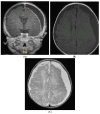The Epidemiology, Management and Therapeutic Outcomes of Subdural Empyema in Neonates with Acute Bacterial Meningitis
- PMID: 38667053
- PMCID: PMC11047628
- DOI: 10.3390/antibiotics13040377
The Epidemiology, Management and Therapeutic Outcomes of Subdural Empyema in Neonates with Acute Bacterial Meningitis
Abstract
Background: Subdural empyema is one of the more serious complications of bacterial meningitis and therapeutic challenges to clinicians. We aimed to evaluate the clinical characteristics, treatment, and outcome of subdural empyema in neonates with bacterial meningitis. Methods: A retrospective cohort study was conducted in two medical centers in Taiwan that enrolled all cases of neonates with subdural empyema after bacterial meningitis between 2003 and 2020. Results: Subdural empyema was diagnosed in 27 of 153 (17.6%) neonates with acute bacterial meningitis compared with cases of meningitis without subdural empyema. The demographics and pathogen distributions were comparable between the study group and the controls, but neonates with subdural empyema were significantly more likely to have clinical manifestations of fever (85.2%) and seizure (81.5%) (both p values < 0.05). The cerebrospinal fluid results of neonates with subdural empyema showed significantly higher white blood cell counts, lower glucose levels and higher protein levels (p = 0.011, 0.003 and 0.006, respectively). Neonates with subdural empyema had a significantly higher rate of neurological complications, especially subdural effusions and periventricular leukomalacia. Although the final mortality rate was not increased in neonates with subdural empyema when compared with the controls, they were often treated much longer and had a high rate of long-term neurological sequelae. Conclusions: Subdural empyema is not uncommon in neonates with acute bacterial meningitis and was associated with a high risk of neurological complications, although it does not significantly increase the final mortality rate. Close monitoring of the occurrence of subdural empyema is required, and appropriate long-term antibiotic treatment after surgical intervention may lead to optimized outcomes.
Keywords: Streptococcus agalactiae; bacterial meningitis; late-onset sepsis; neurological sequelae; subdural empyema.
Conflict of interest statement
The authors declare no conflict of interest.
Figures



Similar articles
-
Pediatric subdural empyema as a complication of meningitis: could CSF protein/CSF glucose ratio be used to screen for subdural empyema?Eur J Pediatr. 2021 Feb;180(2):415-423. doi: 10.1007/s00431-020-03791-5. Epub 2020 Sep 1. Eur J Pediatr. 2021. PMID: 32875444
-
Neurological Complications in Young Infants With Acute Bacterial Meningitis.Front Neurol. 2018 Oct 24;9:903. doi: 10.3389/fneur.2018.00903. eCollection 2018. Front Neurol. 2018. PMID: 30405525 Free PMC article.
-
The Clinical Characteristics, Microbiology and Risk Factors for Adverse Outcomes in Neonates with Gram-Negative Bacillary Meningitis.Antibiotics (Basel). 2023 Jun 30;12(7):1131. doi: 10.3390/antibiotics12071131. Antibiotics (Basel). 2023. PMID: 37508227 Free PMC article.
-
Obscure manifestations of Salmonella subdural empyema in children: case report and literature review.Childs Nerv Syst. 2011 Apr;27(4):591-5. doi: 10.1007/s00381-010-1274-z. Epub 2010 Sep 7. Childs Nerv Syst. 2011. PMID: 20821214 Review.
-
Streptococcus bovis infection of the central nervous system: report of two cases and review.Clin Infect Dis. 1997 Oct;25(4):819-23. doi: 10.1086/515537. Clin Infect Dis. 1997. PMID: 9356795 Review.
References
-
- Okike I.O., Johnson A.P., Henderson K.L., Blackburn R.M., Muller-Pebody B., Ladhani S.N., Anthony M., Ninis N., Heath P.T. Incidence, etiology, and outcome of bacterial meningitis in infants aged < 90 days in the United Kingdom and Republic of Ireland: Prospective, enhanced, national population-based surveillance. Clin. Infect. Dis. 2014;59:e150–e157. - PubMed
-
- Okike I.O., Ladhani S.N., Johnson A.P., Henderson K.L., Blackburn R.M., Muller-Pebody B., Cafferkey M., Anthony M., Ninis N., Heath P.T. Clinical characteristics and risk factors for poor outcome in infants less than 90 days of age with bacterial meningitis in the United Kingdom and Ireland. Pediatr. Infect. Dis. J. 2018;37:837–843. doi: 10.1097/INF.0000000000001917. - DOI - PubMed
LinkOut - more resources
Full Text Sources

